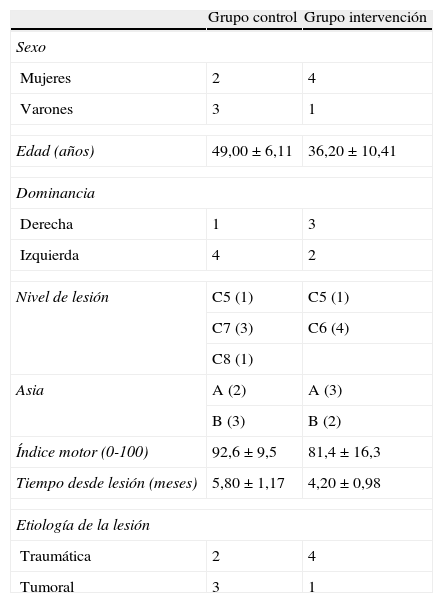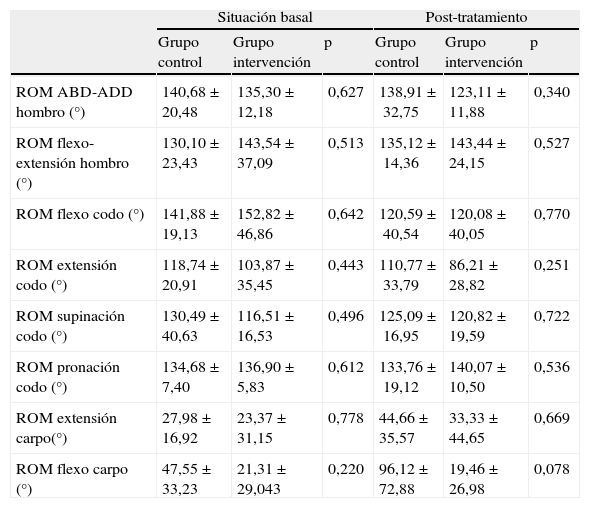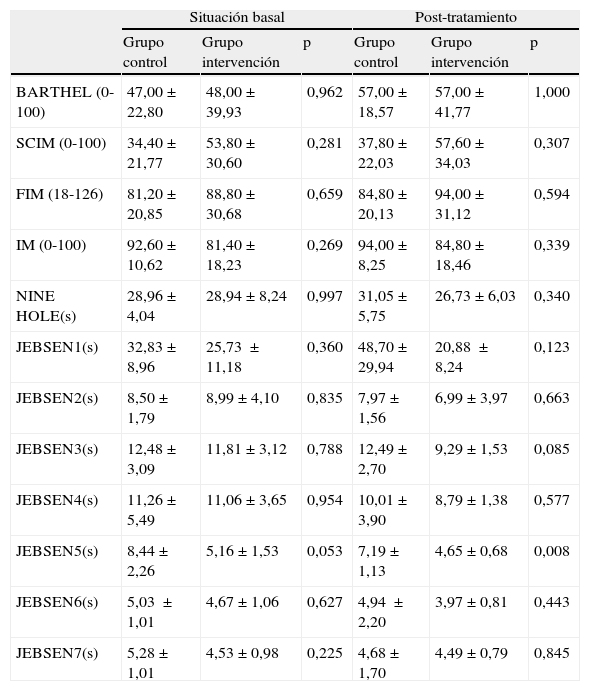Recientemente estamos asistiendo a la introducción de dispositivos basados en realidad virtual (RV) como una de las novedades más relevantes en la neuro-rehabilitación.
ObjetivoEl objetivo es analizar la eficacia de un nuevo sistema de RV denominado TOyRA como herramienta de tratamiento en neuro-rehabilitación para personas con tetraplejia por lesión medular (LM).
Materiales y métodosSe trata de un estudio prospectivo, controlado, en el que se incluyeron 10 pacientes con tetraplejia por LM cervical. El sistema TOyRA consiste en un dispositivo que captura el movimiento basado en sensores inerciales que permite la reproducción de los movimientos del paciente por parte de un avatar en un monitor. La intervención consistió en la aplicación de sesiones de actividades de la vida diaria (AVD) a los 5 pacientes del grupo intervención como complemento a la terapia tradicional frente a un grupo control de otros 5 pacientes en los que solo se realizó terapia convencional. Las variables analizadas fueron cinemáticas y funcionales.
ResultadosSe encontraron mejorías en el grupo tratado con TOyRA en el uno de los subtest del Jebsen-Taylor Hand Function (p<0,05). Se sugieren mejorías tanto en los parámetros cinemáticos de flexión de hombro y pronación de antebrazo como en otras escalas funcionales.
ConclusionesEl sistema de RV TOyRA se presenta como una herramienta terapéutica que puede ofrecer mejores resultados funcionales que la realización en solitario de los métodos tradicionales en el tratamiento de los déficits motores de los miembros superiores en lesionados medulares.
We have recently been witnessing the introduction of devices based on virtual reality (VR) as one of the most important changes in neuro-rehabilitation.
ObjectiveThe objective is to analyze the efficacy of a new system called TOyRA virtual reality as a treatment tool in neuro-rehabilitation for people with quadriplegia due to spinal cord injury (SCI).
Materials and methodsThis is a prospective, controlled study that included 10 patients with SCI induced cervical quadriplegia. The TOyRA system consists of a device capturing motion-based inertial sensors that allows the reproduction of the patient movement by an avatar on a monitor. The intervention consisted of implementing sessions of activities of daily living activities (ADL) to the 5 patients in the intervention group as a complement to traditional therapy versus a control group of 5 other patients in whom only conventional therapy was performed. The analyzed variables were kinematic and functional ones.
ResultsThere were improvements in the TOyRA treated group in one of the subtests of the Jebsen-Taylor Hand Function (P<0.05). Improvements in both the kinematic parameters of shoulder flexion and forearm pronation as in other functional scales were suggested.
ConclusionsThe TOyRA system is presented as a therapeutic tool that can provide better functional outcomes than when the traditional procedure are performed alone in the treatment of upper limb motor deficits in spinal cord injuries.
Artículo
Comprando el artículo el PDF del mismo podrá ser descargado
Precio 19,34 €
Comprar ahora













